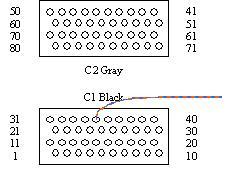Those two voltages will tell us which direction to go next. Usually the 12 volt feed will be there because it is spliced in with the injectors and coil pack so if that entire circuit is dead, the engine wouldn't run.
The second wire should have roughly 4 - 11 volts. The lower the voltage, the greater the DIFFERENCE in voltage between them meaning the greater the electromagnet it's creating and the more output you'll get. The voltage regulator is incapable of drawing that voltage all the way down to 0 volts, so if that's what you find, either the brushes are open from wear and there will be no output from the alternator, or that wire is shorted to ground and you'll have way too much output. Worn brushes are real common and on many older models can be replaced without even removing the alternator from the engine.
If you find exactly the same voltage on both wires, there is an open circuit after that point. It's possible it could be an open regulator circuit but it's much more likely you'll find a break in the wire going to it. You can find that by measuring the voltage at the connector terminals on that wire, or by grounding that wire at various accessible test points. If you ground that wire at a connector terminal and the output goes way up, you know everything is good up to that point.
Sounds like the battery might have been disconnected or run dead recently. You probably did that when you replaced the alternator. If so, the Engine Computer lost its memory and has to relearn "minimum throttle" before it will know when it must be in control of idle speed. It also might not give you the normal "idle flare-up" to 1500 rpm when you start the engine. To meet the conditions for the relearn to take place, drive at highway speed with the engine warmed up, then coast for at least seven seconds without touching the brake or gas pedals.
Thursday, June 7th, 2012 AT 7:22 PM



